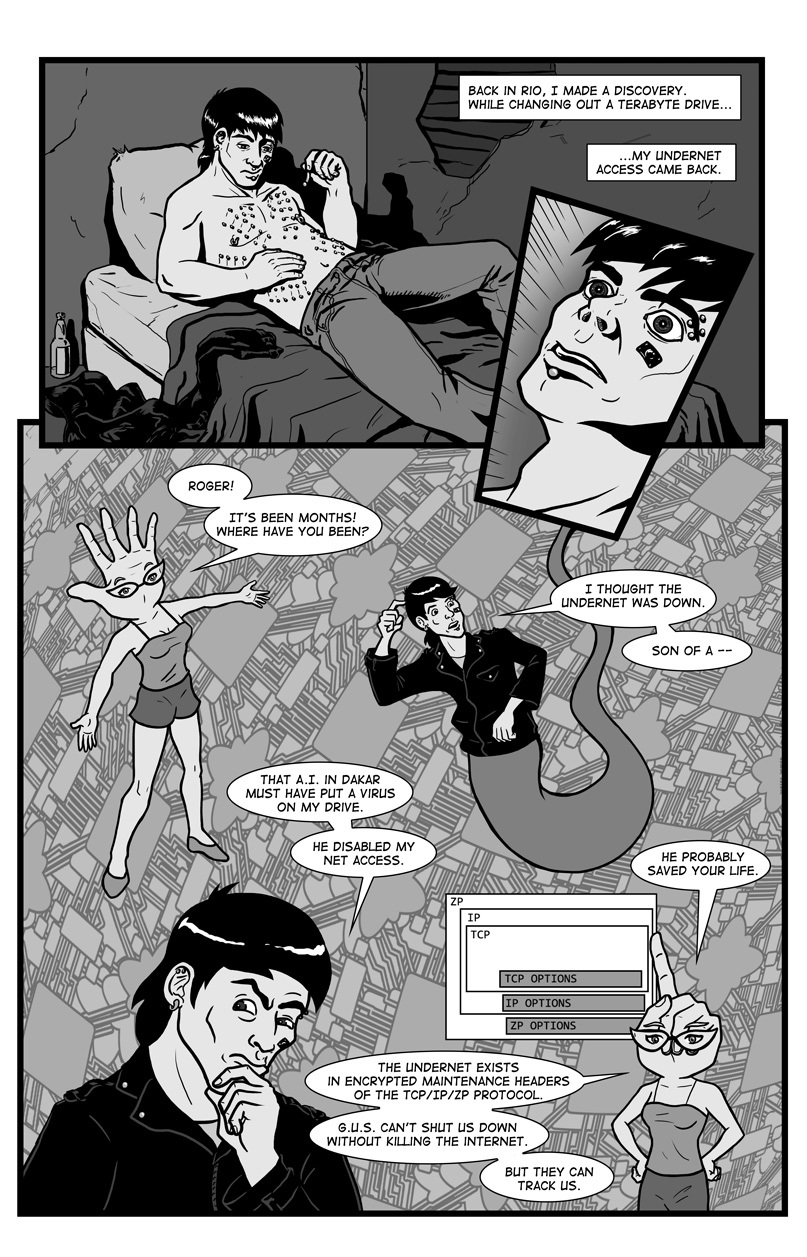Let’s go back to Rio now, and — hey, it’s the reappearance of Zoey the editor! And our first (and likely only) shot of Roger without a shirt on! And an explanation of the Undernet — which, by the way, is completely accurate except for the speculative ‘zp’ protocol wrapper. I didn’t realize how many neat things were on this page until now. 🙂
↓ Transcript
Roger voiceover: Back in Rio, I made a discovery. While changing out a terabyte drive...my Undernet access came back.
Zoey: Roger! It's been months! Where have you been?
Roger: I thought the Undernet was down. Son of a -- That A.I. in Dakar must have put a virus on my drive. He disabled my net access.
Zoey: He probably saved your life. The Undernet exists in encrypted maintenance headers of the TCP/IP/ZP protocol. G.U.S. can't shut us down without killing the internet. But they can track us.
Zoey: Roger! It's been months! Where have you been?
Roger: I thought the Undernet was down. Son of a -- That A.I. in Dakar must have put a virus on my drive. He disabled my net access.
Zoey: He probably saved your life. The Undernet exists in encrypted maintenance headers of the TCP/IP/ZP protocol. G.U.S. can't shut us down without killing the internet. But they can track us.









I had no idea what TCP/IP Protocols meant, so I tried looking it up. Half an hour or more later I still don’t know what it really means (more than “its how computers recognise stuff being sent to/from them when using the internet”) and now I’m confused about several more things. This isn’t actually a bad thing.
Now to see what’s going on with Zoey
Great to have Zoey back!
But it’s funny to hear Roger say “Back in Rio”, because he was all the time in Rio…
Does this mean they’re exposed again? Has Roger’s instinct for vanishing faltered? Johnny Planecrasher might have considered mentioning this.
I thought the internet was gone and undernet was its nth generation descendant, but it’s really a stealth protocol that supports a sub-web?
Roger’s avatar has implants now (digital implants), and if Zoey resembles hers from the neck down, I look forward to meeting her in reality.
Thank you, Darls. The official nickname for the A.I. in Dakar is now ‘Johnny Planecrasher’. 🙂
And yes, the internet — our current internet — supports a stealth sub-web. I have no knowledge about whether or not it’s currently being used.
As a network engineer, I find this to be fairly amusing techno-babble, though it does imply an interesting form of pseudo-steganography, hidden from casual view in normal traffic, but easily visible (though probably not decodable) to anyone watching traffic.
Hiding encrypted data in options headers though, that requires traffic to hijack, and lots of it. A packet with no data, just options headers would be rather rare, and could probably just be discarded by censors without harming the internet at large, ditto for packets containing more options data than payload for the most part (though of course I have no idea about the potential for hiding something in ZP 😉 )
I would have to wonder though, what it is that prevents censorship of single packets if they can in fact be detected?
From this level of future tech, I’d really expect more true steganography though. information coded in spam emails sent directly from peer to peer, in variations in HTTP user agents, list of installed plugins, tracking cookies, side-channels in TLS traffic, encoding errors in video streams of cat-webcams… ah, well, I should stop complaining about reversing the polarity, and just enjoy the show I suppose. 🙂
Personally, I doubt that true steganography can ever be robust enough to carry arbitrary information.
Hiding messages piggyback over normal net traffic isn’t difficult now; I suspect it’ll get easier as more devices are network capable because data flow will get more ubiquitous. Why bother with agents, plugins, and cookies when you can hook into the architecture they all use anyway?
But thanks for keeping me honest, Jercos! It is just a story, so I need you all to have some suspension of disbelief. 🙂
There is no problem sending arbitrary data with steganography sending random data. The problem is the amount of data that could be sent. A one megabyte message might contain only a kilobyte of concealed information. (I’m not sure what the actual ratios are in today’s systems.) Look at http://www.defcon.org/images/defcon-14/dc-14-presentations/DC-14-Murphy.pdf if you want more information on covert channels. (Covert channels would be a superset of steganography in this case.)